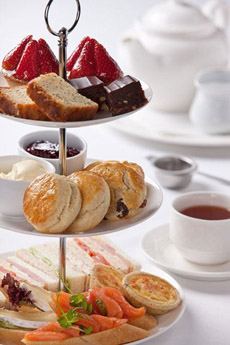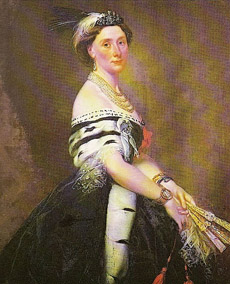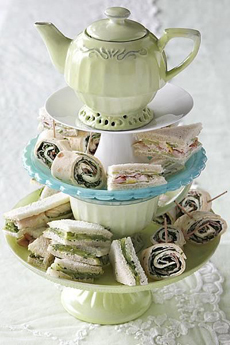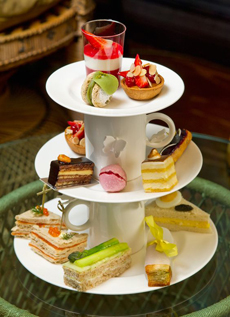|

[1] You don’t need a tiered stand, but you can find inexpensive ones. This one is less than $20 (photo © Chef Buddy | Amazon).

[2] Anna Maria Russell, Duchess of Bedford, inadvertently invented the custom of afternoon tea in 1840 (photo © Woburn Abbey).

[3] Cream tea is a simple version of afternoon tea: just tea and scones with clotted cream and preserves, not the elaborate spread in photo #1 (photo © Kristian Septimius Krogh | iStock Photo.)
|
|
THE HISTORY OF AFTERNOON TEA
In the U.K., afternoon tea is a longstanding tradition: a light meal in mid-afternoon, between lunch and dinner. It can be simple or elaborate, consisting of a pot of tea plus finger sandwiches, scones with jam and clotted cream, cakes and pastries.
September 3rd is the birthday of Anna Maria Russell (1783 – 1857), the seventh Duchess of Bedford. In 1840 she inadvertently created the British custom of afternoon tea, a midday meal.
As their main meal of the day shifted from midday (luncheon) to evening, English high society didn’t dine until 8 p.m. The hungry duchess needed something to tide her over during the stretch between lunch and dinner.
She ordered tea with small sandwiches to be brought to her room. Over time, her friends joined her, and “afternoon tea” expanded from her circle to all of society.
It was an elaborate social and gustatory affair with sweet and savory delicacies, special tea cakes and even tea gowns to bridge the fashion gap between casual afternoon and formal evening dress. As the custom spread downstream, tea rooms and tea gardens opened to serve tea to all classes (no change of clothing required).
Be the Anna of your circle: Plan afternoon teas as regular get-togethers, quarterly or more often. People can take turns hosting; and it can be as simple or elaborate as you like.
While today’s ladies are more likely to work, consider afternoon tea instead of Sunday brunch. Feel free to invite the gentlemen.
Plan a celebration: April is National Afternoon Tea Month, National/International Cream Tea Day is the last Friday in June, and Afternoon Tea Week takes place the second full week in August.
> Afternoon tea and tea dances.
> The history of tea.
> The different types of tea: a photo glossary.
AFTERNOON TEA VS. HIGH TEA VS. CREAM TEA
Afternoon tea is not the same as “high tea.”
High tea is a hearty working class supper traditionally served in the late afternoon or early evening (in modern times generally around 6 p.m.). It is the main meal for the farming and working classes in Britain, a world away from the fashionable afternoon teas enjoyed by the upper classes.
This is perhaps the biggest error made by Americans when discussing tea. Even tea salons that should know better use “high tea” when what they serve is afternoon tea.
The name may sound elegant to Americans, but this is not an upscale repast. It comprises a main dish (generally roast beef or leg of lamb), bread and butter, a pudding (pastry or custard) and tea. It is sometimes called meat tea.
In a seemingly ironic reversal of terms, the afternoon tea of society is sometimes called “low tea,” after the late afternoon feeling of low energy.
Cream tea is a simpler version of afternoon tea, typically consisting of tea, scones, clotted cream, and jam. Afternoon tea is a more elaborate meal with a wider variety of sweet and savory items like finger sandwiches, pastries, and cakes, alongside scones, cream, and jam (photo #3).
> April is National Afternoon Tea Month.
> Afternoon Tea Week takes place the second full week in August.
> National Cream Tea Day is the last Friday in June.
|
CAN YOU SERVE ALCOHOL WITH AFTERNOON TEA?
While it is not part of the tradition, you can add a modern “pre-cocktail” touch:
Liqueur
Pimm’s Cup
Sangria (red, white, rosé)
Sherry: dry or cream sherry
Sparkling wine
A YEAR OF TEA PARTY IDEAS: PART 1, JANUARY TO JULY
JANUARY TEA PARTY
Tea & A Spree. Take advantage of post-holiday sales with a pre- or post-shopping tea party that’s rejuvenating and relaxing. Green tea whole wheat finger sandwiches will help to keep those New Year’s resolutions. A plate of crudités with yogurt dip also helps.
New Year’s Resolution Tea. Who doesn’t resolve to lose weight in the new year? Have a “spa tea”: different kinds of green tea and healthy munchies.
FEBRUARY TEA PARTY
Tea & Bent Knee. Propose over a luxurious tea service, featuring imported Earl Gray tea, Champagne, fresh strawberries and cream and luxurious chocolate cake. If your town has a venue that serves afternoon tea, check it out and reserve a cozy table.
Valentine Potluck Tea. If there’s no proposal at hand, you still deserve a celebration. Have everyone bring their favorite Valentine treat. You supply different teas, from flavored teas like hazelnut and vanilla to elegant Earl Grey and smoky Lapsang Souchong. Everyone can vote on their favorite tea-and-treat pairings.
MARCH TEA PARTY
Tea & A Shillelagh. Pronounced shuh-LAY-lee, a shillelagh is a walking cane also used as a cudgel or “fighting stick.” It’s named after Shillelagh Forest in County Wicklow, Ireland, from whence the wood originally came. But there’s no fighting here: After a pot of Irish tea, shortbread and scones, go for a lovely stroll, with or without your walking stick.
Tea & The Rites Of Spring. Celebrate the end of winter and the beginning of spring (March 21st) with pastel frostings on the cakes and cookies, optional iced tea, fresh tulips and daffodils. If people ask what they can bring, say “tulips” and be prepared to have a room full of them—very springlike! Think of happy spring music, too: Chopin’s works for pianoforte say “spring” to us.
|







